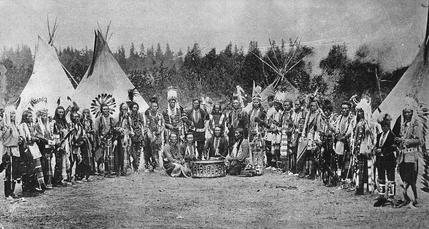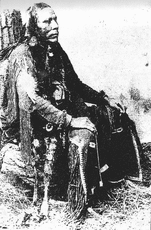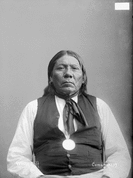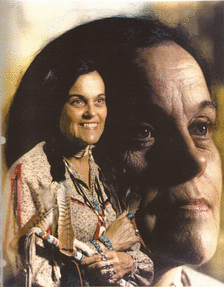In my many travels around the country to Indian Markets, museums and Fine Art Shows, I am frequently asked, “What is the Seventh Generation?”
I will attempt to impart what it personally symbolizes to me based on a lifetime of teachings, thought and prayer.

A Council meeting between Lakota and Cheyenne warriors a few days before the Battle of the Little Bighorn. Grandfather I’nee is the youngest warrior, pictured second from the right.
As with all my writings and talks, please recognize that on this continent now called North America, there were originally over 500 individual nations of People, each with their own teachings, languages and traditions.
What I write today is my own reflection and belief. I share it with you with the best of intention and in the most truthful manner that I can.
The “Seventh Generation” has become almost a universal Native American teaching. To my knowledge, it originated with the Algonquin Peoples of the North East.

My Grandmother’s Grandfather, I’nee (Long Bull)
It has been been repeated not only in the oral traditions of the People, but is widely recognized in all forms of media today and takes a personal meaning to many individuals, from all walks of life.
As I see it, the core of the Seventh Generation teachings is the intent that each generation should consider the effects of their actions and lives on each future generation… to seven generations in the future.
To me, the Teachings of the Seventh Generation imparts much more. It is a reflection of not only the future generations, but also the past and present generations.
Considering the past, there were many recent generations after the decline of our original ways when it was illegal to be “Indian.”

My Grandmother’s Grandfather, White Wolf
As a People, we were forbidden to practice our own religion and beliefs as taught to us by the Creator of All, speak our own languages, to be who and what we were intended. Native Peoples of North America were becoming thrust into a program called “assimilation.”
While most americans were afforded freedom of religion by the Constitution of the United States of America, it would take until the American Religious Freedom Act of 1978 was passed before Native Americans could openly practice the traditional ways that had gone underground since the days the reservations were formed and the policy of assimilation was implemented.
“Some people want the medicine man and woman to share their religious beliefs in the same manner that priests, rabbis and ministers expound publicly the tenets of their denominations; others feel that Indian ceremonials are remnants of primitive life and should be abandoned.” -Vine Deloria

My Grandmother Blackstar
Many of our traditional people (as well as some non-indians) suffered to the point of giving their lives so that what remains of our respective original ways could survive until today.
And so, without the diligence, secrecy and sacrifice of the preceding generations, many more of the original ways would be lost along with our cultural identities.
Today, it is our responsibility to prepare the way for future generations by honoring the past; embracing, protecting and teaching what is remembered to our children. With this knowledge, our cultural identities, our true-selves, can flourish and remain for the next Seven Generations and beyond.
These are my words, reflections and beliefs. I share them with you in the best of intent and take full responsibility for them.
In the words of my Grandmother, Blackstar, “Suvate’ (It is Enough)”.
Tim Blueflint

